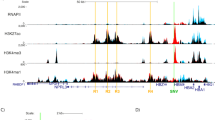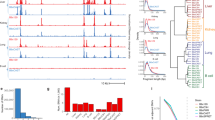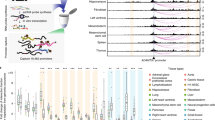Abstract
Insight into the control of gene expression may be gained by analysing genetic systems marked by both regulatory and structural variants. In such systems one can determine whether a regulatory element controls structural genes on both chromosomes or only on the chromosome to which it is linked. The latter may be detected in individuals heterozygous at both the regulatory and structural loci, in which case the effect of each regulatory allele is seen to be exerted only on the cis-located structural allele. In prokaryotic organisms, the identification of cis interaction of this sort has allowed elucidation of many features of genetic regulation, first for the lac operon1 and subsequently for a variety of other systems2. In higher organisms, however, there have been few opportunities to observe cis-interacting genes3–13. The most thoroughly characterized mammalian system in this regard is the murine β-glucuronidase locus described by Paigen and his colleagues14–16, in which cis interaction has been shown to occur between two closely linked genetic elements—the β-glucuronidase structural gene itself and an androgen-activated regulatory gene which controls the quantity of β-glucuronidase expressed. We report here that cis-interacting genetic elements are also found in the S region of the mouse major histocompatibility complex H–2.
This is a preview of subscription content, access via your institution
Access options
Subscribe to this journal
Receive 51 print issues and online access
$199.00 per year
only $3.90 per issue
Buy this article
- Purchase on Springer Link
- Instant access to full article PDF
Prices may be subject to local taxes which are calculated during checkout
Similar content being viewed by others
References
Jacob, F. & Monod, J. J. molec. Biol. 3, 318–356 (1961).
Miller, E. (ed.) The Operon. (Cold Spring Harbor Laboratory, New York, 1979).
Phillips, R. J. Genetics. 51, 485–495 (1966).
Glekeler, W., Faversham, J. & Cohn, M. J. exp. Med. 148, 1122 (1978).
Dickinson, W. J. & Carson, H. L. Proc. natn. Acad. Sci. U.S.A. 76, 4559–4562 (1979).
Dickinson, W. J. Devl Biol. 42, 131–140 (1975).
Boubelik, M., Lengerova, A., Bailey, D. W. & Matousek, A. Devl Biol. 47, 206–214 (1975).
McCaron, M. et al. Genetics. 91, 275–293 (1979).
Daniel, W. L. Biochem. Genet. 14, 1003–1018 (1976).
Carlson, P. Genet. Res. 17, 53–81 (1971).
Jarry, B. & Faulk, D. Molec. gen. Genet. 135, 113–122 (1974).
Rawls, J. W. & Fristrom, F. W. Nature. 255, 738–740 (1975).
Lewis, E. B. Nature. 276, 565–570 (1978).
Paigen, K., Meisler, M., Felton, J. & Chapman, V. Cell. 9, 533–539 (1976).
Swank, R. T. et al. Recent Prog. Horm. Res. 34, 401–438 (1978).
Paigen, K., Labarca, C. & Watson, G. Science. 203, 554–558 (1979).
Shreffler, D. C. & Passmore, H. C. Genetics. 48, 9 (1963).
Roos, M., Atkinson, J. P. & Shreffler, D. C. J. Immun. 121, 1106–1115 (1979).
Lachmann, P. J., Grennan, D. & Martin, A. Nature. 258, 242–243 (1975).
Meo, J., Krasteff, T. & Shreffler, D. C. Proc. natn. Acad. Sci. U.S.A. 72, 4536–4560 (1975).
Ferreira, A., Nussenzweig, V. & Gigli, I. J. exp. Med. 148, 1186–1197 (1978).
Curman, B. et al. Nature. 258, 243–245 (1975).
Hall, R. E. & Colten, H. R. Proc. natn. Acad. Sci. U.S.A. 74, 1707–1710 (1977).
Hansen, T. H., Krasteff, T. N. & Shreffler, D. C. Biochem. Genet. 12, 281–293 (1974).
Ferreira, A., Michaelson, J. & Nussenzweig, V. Z. Immun. (in the press).
Ferreira, A., Michaelson, J. & Nussenzweig, V. J. Immun. 125, 1178–1182 (1980).
Ferreira, A., Michaelson, J. & Nussenzweig, V. Immunogenetics. (in the press).
Passmore, H. C. & Shreffler, D. C. Biochem. Genet. 4, 351–365 (1970).
Passmore, H. C. & Shreffler, D. C. Biochem. Genet. 5, 201–209 (1971).
Hansen, T. H. & Shreffler, D. C. J. Immun. 117, 1507–1513 (1976).
Saunders, D. & Edidin, M. J. Immun. 112, 2210–2218 (1974).
Author information
Authors and Affiliations
Rights and permissions
About this article
Cite this article
Michaelson, J., Ferreira, A. & Nussenzweig, V. cis-Interacting genes in the S region of the murine major histocompatibility complex. Nature 289, 306–308 (1981). https://doi.org/10.1038/289306a0
Received:
Accepted:
Issue Date:
DOI: https://doi.org/10.1038/289306a0
This article is cited by
Comments
By submitting a comment you agree to abide by our Terms and Community Guidelines. If you find something abusive or that does not comply with our terms or guidelines please flag it as inappropriate.



